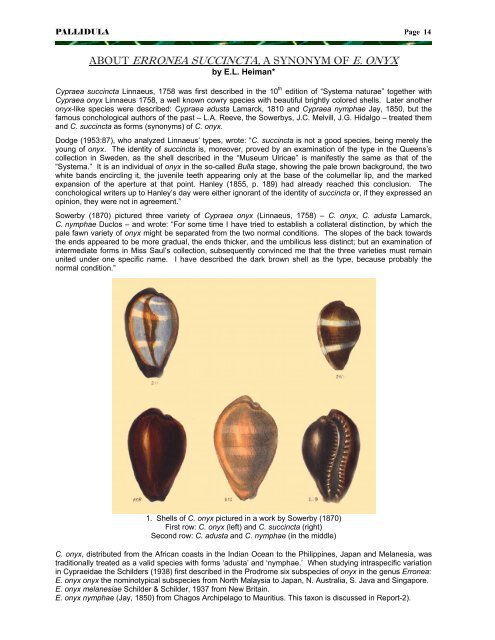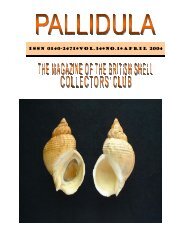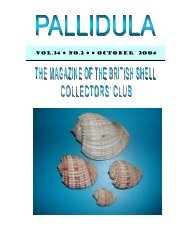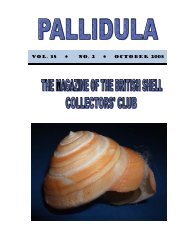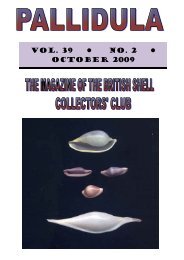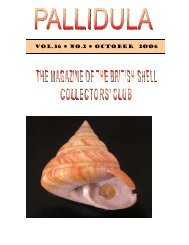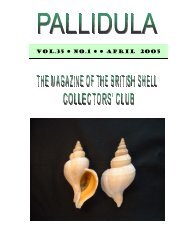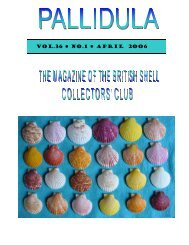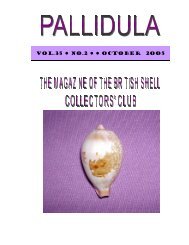VOL.37 NO.1 APRIL 2007 - British Shell Collectors' Club
VOL.37 NO.1 APRIL 2007 - British Shell Collectors' Club
VOL.37 NO.1 APRIL 2007 - British Shell Collectors' Club
Create successful ePaper yourself
Turn your PDF publications into a flip-book with our unique Google optimized e-Paper software.
PALLIDULA Page 14<br />
ABOUT ERRONEA SUCCINCTA, A SYNONYM OF E. ONYX<br />
by E.L. Heiman*<br />
Cypraea succincta Linnaeus, 1758 was first described in the 10 th edition of “Systema naturae” together with<br />
Cypraea onyx Linnaeus 1758, a well known cowry species with beautiful brightly colored shells. Later another<br />
onyx-like species were described: Cypraea adusta Lamarck, 1810 and Cypraea nymphae Jay, 1850, but the<br />
famous conchological authors of the past – L.A. Reeve, the Sowerbys, J.C. Melvill, J.G. Hidalgo – treated them<br />
and C. succincta as forms (synonyms) of C. onyx.<br />
Dodge (1953:87), who analyzed Linnaeus’ types, wrote: “C. succincta is not a good species, being merely the<br />
young of onyx. The identity of succincta is, moreover, proved by an examination of the type in the Queens’s<br />
collection in Sweden, as the shell described in the “Museum Ulricae” is manifestly the same as that of the<br />
“Systema.” It is an individual of onyx in the so-called Bulla stage, showing the pale brown background, the two<br />
white bands encircling it, the juvenile teeth appearing only at the base of the columellar lip, and the marked<br />
expansion of the aperture at that point. Hanley (1855, p. 189) had already reached this conclusion. The<br />
conchological writers up to Hanley’s day were either ignorant of the identity of succincta or, if they expressed an<br />
opinion, they were not in agreement.”<br />
Sowerby (1870) pictured three variety of Cypraea onyx (Linnaeus, 1758) – C. onyx, C. adusta Lamarck,<br />
C. nymphae Duclos – and wrote: “For some time I have tried to establish a collateral distinction, by which the<br />
pale fawn variety of onyx might be separated from the two normal conditions. The slopes of the back towards<br />
the ends appeared to be more gradual, the ends thicker, and the umbilicus less distinct; but an examination of<br />
intermediate forms in Miss Saul’s collection, subsequently convinced me that the three varieties must remain<br />
united under one specific name. I have described the dark brown shell as the type, because probably the<br />
normal condition.”<br />
1. <strong>Shell</strong>s of C. onyx pictured in a work by Sowerby (1870)<br />
First row: C. onyx (left) and C. succincta (right)<br />
Second row: C. adusta and C. nymphae (in the middle)<br />
C. onyx, distributed from the African coasts in the Indian Ocean to the Philippines, Japan and Melanesia, was<br />
traditionally treated as a valid species with forms ‘adusta’ and ‘nymphae.’ When studying intraspecific variation<br />
in Cypraeidae the Schilders (1938) first described in the Prodrome six subspecies of onyx in the genus Erronea:<br />
E. onyx onyx the nominotypical subspecies from North Malaysia to Japan, N. Australia, S. Java and Singapore.<br />
E. onyx melanesiae Schilder & Schilder, 1937 from New Britain.<br />
E. onyx nymphae (Jay, 1850) from Chagos Archipelago to Mauritius. This taxon is discussed in Report-2).


